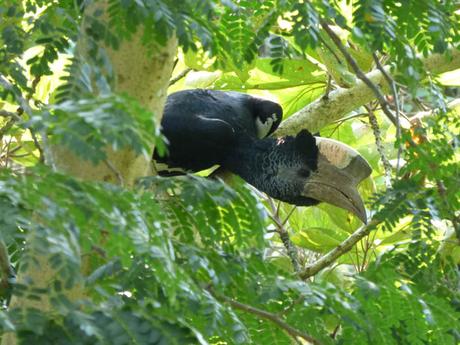
Birdwatching my way through lockdown in Kibale Forest
Lockdown has found me on the edge of Kibale Forest in western Uganda where I live in a thatched wooden house on stilts a few hundred metres from the elephant trench that marks the boundary of the National Park.
Dawn chorus on the edge of Kibale National Park is so hypnotic that I'm regularly awake by 6.21 every morning, eager not to miss the Lead-coloured Flycatcher's soothing two-note call, my usual morning alarm.
By contrast, the past few awakenings have been rather jarring. They may be grand birds on the wing but, when they are calling from your roof, Hornbills are not always so welcome!
I spend the first hour of every day birdwatching and drinking tea on the balcony at the front of my house. Here on the Equator, it gets light around 7 o'clock throughout the year.
The black-and-white Casqued Hornbills are bouncing around the fig tree before dawn. One hop, two hop, a Hornbill with a black head and matching casque hops up and down the tree boosted by a big flap of its wings. The branch sags low under its weight. The bird picks a small green fig the size of a Malteser with its cumbersome-looking beak. It throws back its almighty casqued head to swallow it. (It looks like a lot of effort for a tiny fruit). These sometimes-clumsy birds are dainty eaters. Who would have guessed?
A pair of Hornbills are joined by a third. As I watch, bird number one feeds the third one. Could this giant be their baby? They wipe their beaks left and right against the lichen-covered trunk. A bird bangs its hollow casque on a branch; the unusual noise fills the air.
There's a flash of blue! The first of the Great Blue Turacos glides in.
Another Hornbill glides down onto a branch on the edge of Kibale Forest 500 metres from where I'm sitting. I trace its distinct silhouette against the dark green background.
It seems impossible that my movement might scare these noisy birds, but they panic easily. Seven Hornbills fly noisily into the forest. Smaller birds scatter in their wake.
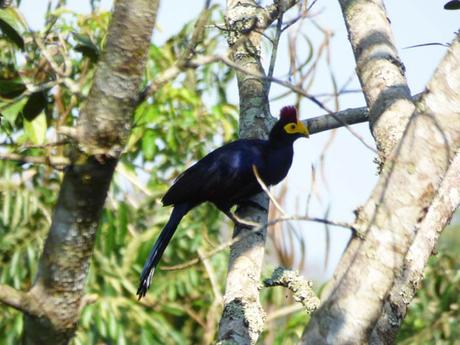
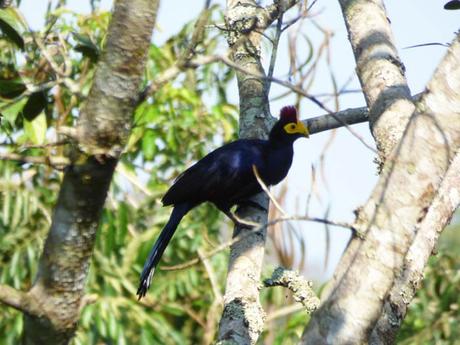 Ross's Turaco. Kibale Forest Uganda. Charlotte Beauvoisin
Ross's Turaco. Kibale Forest Uganda. Charlotte Beauvoisin
The light is too poor for the camera so I just sit and watch. A pair of Ross's Turacos hop and creep up the tree trunks. I contrast the dainty hops of the Ross's with the clumsy antics of the Great Blue Turacos bouncing and crashing through the branches.
The sound of heavy wing beats signals the arrival of another Hornbill; a second loud wing beat follows close behind. They settle in the fig tree. Single caws suggest happiness and contentment.
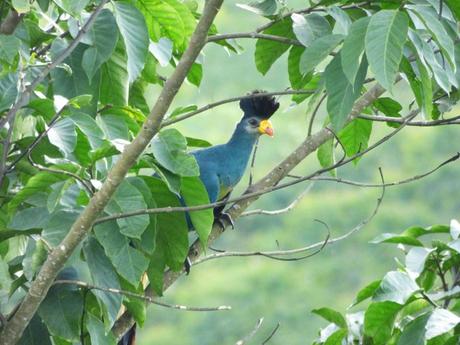
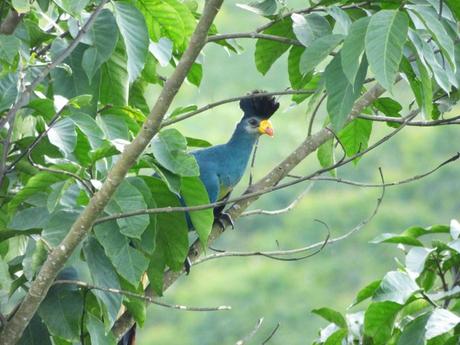 Great Blue Turaco, Sunbird Hill, Kibale Forest. Charlotte Beauvoisin
Great Blue Turaco, Sunbird Hill, Kibale Forest. Charlotte Beauvoisin
Small birds swoop in twos and threes. They are non-descript in the early morning light. As the minutes pass, their blue sheen confirms they are purple-headed starlings.
Violet-backed Starlings now number more than 20. In bright sunshine, the plumage of these same birds appears bright pink. I love the seasonal twittering of flocks of starlings.
The caws have subdued. Six Hornbills sit silently except for the occasional beat of a wing as they move through the branches, scouring the tree for figs. The slender branches of this inconspicuous tree are stronger than they look.
From the village a few kilometres away, I hear the repetitive cawing and screeching of more Hornbills. As I watch the tree over the days and weeks that the figs are ripe, I notice a pattern: the Hornbills call loudly from the village before one, two, three birds fly towards the forest. They pause here at Sunbird Hill for a few minutes before resuming their flight to the forest where they pass the day. Wave after wave of twos and threes pass overhead every morning and evening.
By contrast, Great Blue Turacos can - believe it not - be far quieter.
I recall a morning when I heard leaves dropping from the canopy of another fig tree by my house. I looked up, amazed to see 12 GBTs gobbling figs. When the fruits are ripe, turacos glide in stealthily; the only thing you might hear is the whirr of wings, not a single call. While they feed, the only sounds are leaves and figs dropping to the ground. Disturb them and the mass evacuation will be panicked and noisy! Their feeding habits are in marked contrast to their otherwise gregarious behaviour.
I once spotted both Meyer's and African Grey Parrots feeding in this same tree. "It's very rare to see these two parrot species together" said our friend Ronald, a ranger and tourism warden with the Uganda Wildlife Authority.
A Hornbill heaves into flight. It flies head-first in my direction, veering to the right as it passes within ten feet of me.
One, two, four Hornbills depart for the warmth of the sunlit trees on the forest edge. There is a moment of quiet.
With little noise and no drama, the Great Blue Turaco population of the fig tree now numbers eight or more. The diversity of large fruit-eating birds is a sign of the forest's abundance.
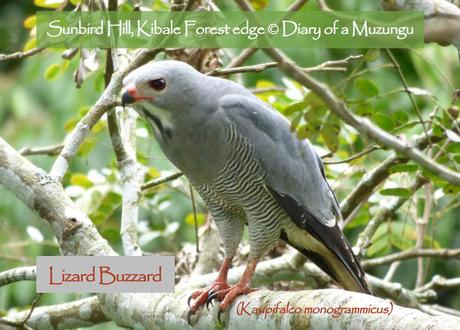
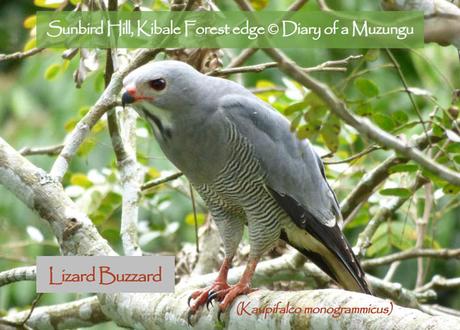 Lizard Buzzard. Sunbird Hill, Kibale Forest edge, Uganda. Photo by Charlotte Beauvoisin
Lizard Buzzard. Sunbird Hill, Kibale Forest edge, Uganda. Photo by Charlotte Beauvoisin
A flash of grey feathers catches my eye as I am sitting at the laptop. Seconds later, this striking Lizard Buzzard (plus wriggling lunch) lands in the tree a few metres from my desk. The remains of a long tail suggest it was eating a snake. (It was intriguing to note the reptile's tail was still flexing, five minutes into the lunch session!)
Mid-afternoon the birdsong is almost deafening. (Who can work with so much distraction?) I am drawn onto the balcony to just sit amid the music. Two species of starlings entertain me. The African Blue Flycatcher and Red-bellied Paradise Flycatcher weave colourful patterns in the lower branches of the fig trees. After a short absence, the Black-and-white (Vanga) Shrike flycatchers are back. A flash of red signals the head feathers of a Yellow-spotted Barbet. Hairy-breasted and Double-toothed Barbets are occasional afternoon visitors. Last year, this same fig tree was full of Barbets for several weeks; this year Hornbills, Turacos and Starlings steal the show.
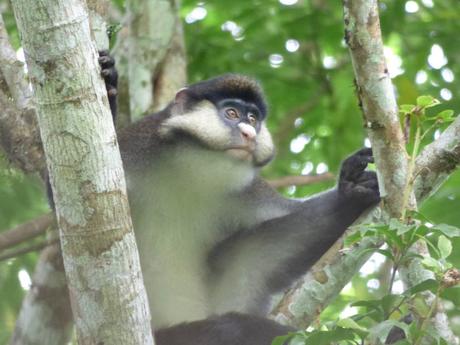
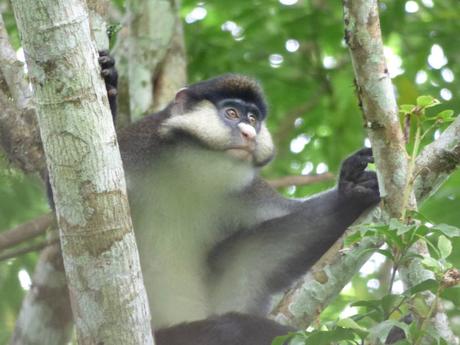 Red-tailed Monkey "nkima" Kibale Forest Uganda. Charlotte Beauvoisin
Red-tailed Monkey "nkima" Kibale Forest Uganda. Charlotte Beauvoisin
As dusk approaches, a primate face peers through the bright green foliage of a medium-sized tree. It's a dark-haired monkey with a white snub nose and white cheeks. It leans forward to grab young shoots and reclines to reveal a white belly. It's one of many monkey visitors to the ripe fig tree. Each species has their timeslot; the Red-tailed Nkima Monkey appears after birds have had their fill.
I wrote this episode of my #LockdownDiaries for Alan Davies and Ruth Davies who are best known for identifying a record-breaking 4,341 bird species on their gruelling one-year world tour. You can read the original story on their website: A View From Uganda - A Forest Wakes Up - Kibale National Park. Alan and Ruth are regular birdwatching visitors to Uganda and we hope to see them here at Sunbird Hill one day!

